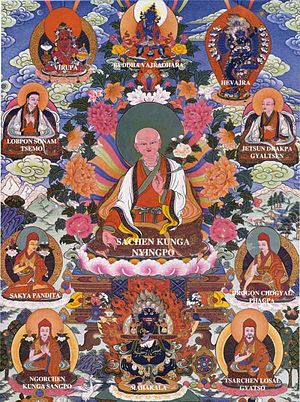Sakya
Sakya (Tib. ས་སྐྱ་, Wyl. sa skya) is one of the four schools of Tibetan Buddhism. It takes its name from the Sakya Monastery, founded by Khön Könchok Gyalpo in 1073. The name Sakya literally means 'grey earth', and is a reference to the unusually pale colour of the earth at the site. Due to the widespread influence of the monastery's earliest masters, especially the so called 'Five Sakya Patriarchs', it quickly developed into one of the main schools in Tibet, developing a special reputation for scholarship. The most important teaching within the Sakya tradition is the Lamdré, or 'Path with Its Fruit', a series of meditation instructions associated with the Hevajra Tantra.
The Sakya tradition was the second to arise from the new transmission period at the end of the 10th century. The Sakya lineage derives from the Indian yogi Virupa and some other translators.
- Their main teaching from Virupa is known as “lamdre” – lam is path and dre is result. This “path and its results” system is a combination of lam-rim type material conjoined with the tantric practice of Hevajra.[1]
This leader of this tradition is called the Sakya Trizin. The Sakya Pandita (1182–1251CE) was one of its most famous exponents.
Subschools
The two main subschools are:
- Ngor, founded by Ngorchen Kunga Zangpo (1382-1456). It is characterized by its rigorous discipline and knowledge of the tantras. Luding Khen Rinpoche, one of the sons of Jetsün Kushok Chimey Luding, is the present head of this school.
- Tsar, founded by Tsarchen Losal Gyatso (1502-1566). The Tsar lineage is renowned for its teachings on the greater and lesser Mahakala, and the transmissions of ‘Thirteen Golden Dharmas’. Its main monastery in Tibet was Dar Drangmoche Monastery in Tsang, and now in exile Tashi Rabten Ling at Lumbini, along with two other monasteries in Kathmandu, Nepal that represent the Tsar lineage. His Eminence Chogye Trichen Rinpoche who passed away in 2007 was the head of the Tsar lineage.
Other subschools are:
- The Dzongpa tradition founded by Dzongpa Kunga Namgyal (1432-1496.)
Notes
- ↑
 How Did Tibetan Buddhism Develop?, StudyBuddhism
How Did Tibetan Buddhism Develop?, StudyBuddhism
Further Reading
- Chogay Trichen, The History of the Sakya Tradition, Ganesha Press, 1983, ISBN 978-0950911908
- Bodhi Magazine, Fall Issue 2009, 'The Glorious Sakya: Lineage of Path and Result'
External Links
- The Official website of His Holiness the Sakya Trizin
- Sakya Resource Guide by Jeff Watt
- Treasury of Lives
- Tradition - Sakya Main Page at Himalayan Art
| This article includes content from Sakya on Rigpawiki (view authors). Licensed under CC BY-NC 3.0 |

